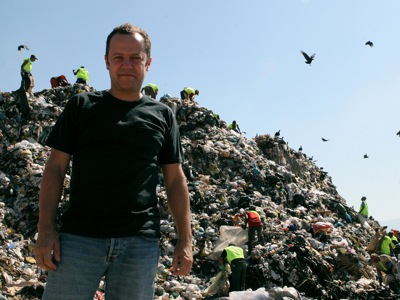The Dirtiest Art Project
Documentary Explores Lives of Brazilian Landfill Sorters

At Jardim Gramacho, the world’s largest garbage dump located outside of Rio de Janeiro, Brazil, things aren’t just discarded and forgotten. Among heaps of waste, a community thrives: babies are born, classic novels are salvaged, and Irma, a trained restaurant cook, serves up hot meals to the catadores, the men and women who sort the dump for recyclable materials. She cooks over an open fire, under two large, faded yellow umbrellas. “You know how I became famous all over the world? In the garbage,” Irma says.
Irma is one of six catadores featured in 2010 documentary Waste Land, which drew a packed house for a free screening at UCSB’s Pollock Theater last Wednesday. The film follows a group of catadores as they leave the landfill for two weeks to work with Brazilian artist Vik Muniz. He guides them through the task of turning their own photographic portraits into giant mosaics of delicately arranged trash.
Though the film doesn’t offer much insight on the artistic process itself, viewers get a glimpse into the personal transformations of the catadores as they are removed from their own reality and start to see themselves in a new light. Both Muniz and director Lucy Walker, who stayed for a Q&A session after the screening, said they were drawn to the project not because of its environmental story nor its unusual setting, but because of its “human factor.”
The film manages to avoid the potential pity party that can accompany documentaries about working poor communities, and captures not only the intensity of each individual’s story but also their pride, humility, and contagious sense of humor. Although its environmental message is secondary, Waste Land is also a unique commentary on consumer waste and conservation. Trucks pick up your trash and take it somewhere hidden from view, but “when you’re standing on a landfill, you realize this stuff doesn’t vanish at all,” said director Walker.
Jardim Gramacho is really the only place in Rio de Janiero where “the millionaire’s mansion mixes with the garbage of the poorest favela [slum],” said Muniz. While recycling and environmentalism are on the rise in North America, the catadores make their livings picking up other people’s waste—the film displays a sad irony to the fact that it takes such a physical confrontation of our trash to understand the value of a plastic bottle.
Among the mountains of waste, Muniz photographs Isis in his first week at Gramacho, picking out recyclables in bright red sweaters and mini-skirts, with protective leggings on bottom and earrings to match. Bubbly and vivacious, only later does she reveal the tragedy that sits on her mind: her son’s death, which she describes down to the ant crawling across his small body at the morgue.
The documentary cooperates with the art in such a way that, as Walker put it, it’s hard to tell where Muniz ends and the movie begins. With his work, the view from up close differs from the view from afar. Zoom in, and you see discarded bottle caps, dust, and plastic yogurt cups; zoom out, and you see Isis leaning over a hot iron, stringy brown hair hanging down one side of her face. By the end, we see the catadores not only as the subjects and creators of artwork, but also as individuals whose remarkable stories are born out of the trash at Jardim Gramacho.
Waste Land doesn’t attempt to minimize the hardships faced by catadores. For some, the contrast between creating art and picking trash brought a desire for change, for better or for worse. “It changed a lot for me. Now I don’t see myself in the garbage,” Isis said, after seeing her completed portrait. “I don’t want to go back to the garbage.”
Muniz first described the dump as the place “where everything that’s not good goes, including the people.” But the trash that ends up at Gramacho defines and sustains lives.
“I started working there almost 30 years ago,” Irma tells her grandchildren, as they look at her portrait hanging on the wall. “I like it there. My life began there, thank God. I’m famous all over the world because of that place. That’s where everything started for me.”



